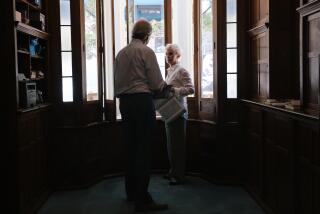Church Is Also Home Sweet Home--Huge, Renovated Vintage House
- Share via
During the week, the room is Alan Dan Orme’s living room. But on Sundays the folding chairs are set out, and the room is transformed into the meeting place for the University Church of Athens, Ga.
“We deliberately did not make the room look like a church,” said Orme, 56, who is pastor. He added that the living room environment creates a feeling of camaraderie among worshipers.
Though not common, house churches are an accepted form of ministry, according to a Presbyterian official, and they are particularly suited to small congregations, which might find larger quarters too costly to maintain.
Orme, an ordained minister since 1960 of the Presbyterian Church in America, has spent 13 years renovating the 17-room house, which he described as typically 19th-Century Southern middle-class with a steep hip roof.
He dates the major part of the house from 1897, when it was added to a chapel that was used as early as the 1850s. The room where services now take place was added to the back of the house by Orme, who used secondhand materials to keep costs down.
Among his innovations are storage compartments in the crawl space for up to 75 folding chairs, generally more than enough for the weekly worshipers.
It’s a busy house at all times, with regular weekly potluck suppers for 25 and other church activities. Orme also rents rooms to a half-dozen University of Georgia students, and former students often return to visit, spending the night in one of the parlors, which he has outfitted with sleeping balconies.
Orme is comfortable with his craft. He was a builder and restorer of houses in Elmira, N.Y., his hometown, before he earned graduate degrees in Greek and history and served as a missionary, academic dean and minister.
He recently wrote a book about renovation, “Reviving Old Houses” (Storey-Garden Way Publishing, Pownal, Vt., $16.95 or $8.95 in paperback). It details some of the low-cost tricks of the trade.
Orme says the key to successful renovation of vintage homes is to make the place comfortable for modern living while keeping the old-fashioned character.
For example, he installed modern appliances--including a dishwasher--in the kitchen and put showers in the bathrooms. But he kept such details as old wood floors, exposed wood beams in the kitchen and antique lighting fixtures. Kitchen cabinets were made by cutting down turn-of-the-century Hoosier cabinets. He aged modern flush doors by covering them with panels and painting them.
He says ceiling light fixtures are particularly destructive to the ambiance in an old house. If they were installed during an earlier renovation, remove them. Use the wiring for ceiling fans, which add old fashioned atmosphere to most rooms.
Redoing an old house that needs a lot of work, says Orme, is a matter of setting priorities: Do essential repairs to safeguard the house from further disintegration first. For example, instead of redoing an uneven wall--which isn’t urgent--hang a rug or tapestry to hide it.
“That way you can ignore it for 10 years while you work on something more important,” he said.
Often a restorer must contend with previous unattractive remodeling efforts. If windows have been cut down and now appear too small, install shutters to visually enlarge the opening and mount window boxes under them to give them importance.
Orme says typical renovation projects guaranteed to lower the value of an old house include: reducing the size of, or screening, a porch; modernizing the main entrance, adding artificial siding, lowering a high ceiling and dividing rooms.
Large rooms, gingerbread decor and traditional building materials are just the features that make old houses worth saving.






